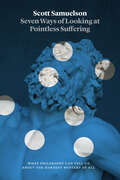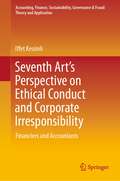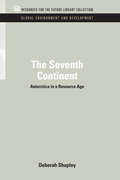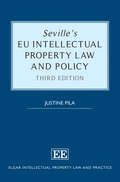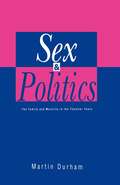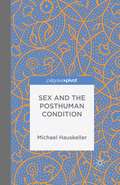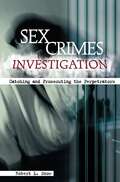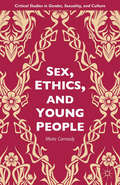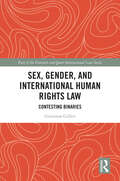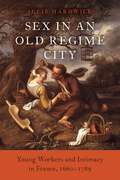- Table View
- List View
The seven veils of privacy: How our debates about privacy conceal its nature
by Kieron O'HaraPrivacy is one of the most contested concepts of our time. This book sets out a rigorous and comprehensive framework for understanding debates about privacy and our rights to it. Much of the conflict around privacy comes from a failure to recognise divergent perspectives. Some people argue about human rights, some about social conventions, others about individual preferences and still others about information and data processing. As a result, ‘privacy’ has become the focus of competing definitions, leading some to denounce the ‘disarray’ in the field. But as this book shows, disagreements about the role and value of privacy obscure a large amount of agreement on the topic. Privacy is not a technical term of law, cybersecurity or sociology, but a word in common use that adequately expresses a few simple and related ideas.
Seven Ways of Looking at Pointless Suffering: What Philosophy Can Tell Us about the Hardest Mystery of All
by Scott SamuelsonIt’s right there in the Book of Job: “Man is born unto trouble as the sparks fly upward.” Suffering is an inescapable part of the human condition—which leads to a question that has proved just as inescapable throughout the centuries: Why? Why do we suffer? Why do people die young? Is there any point to our pain, physical or emotional? Do horrors like hurricanes have meaning? In Seven Ways of Looking at Pointless Suffering, Scott Samuelson tackles that hardest question of all. To do so, he travels through the history of philosophy and religion, but he also attends closely to the real world we live in. While always taking the question of suffering seriously, Samuelson is just as likely to draw lessons from Bugs Bunny as from Confucius, from his time teaching philosophy to prisoners as from Hannah Arendt’s attempts to come to terms with the Holocaust. He guides us through the arguments people have offered to answer this fundamental question, explores the many ways that we have tried to minimize or eliminate suffering, and examines people’s attempts to find ways to live with pointless suffering. Ultimately, Samuelson shows, to be fully human means to acknowledge a mysterious paradox: we must simultaneously accept suffering and oppose it. And understanding that is itself a step towards acceptance. Wholly accessible, and thoroughly thought-provoking, Seven Ways of Looking at Pointless Suffering is a masterpiece of philosophy, returning the field to its roots—helping us see new ways to understand, explain, and live in our world, fully alive to both its light and its darkness.
Seven Ways of Looking at Pointless Suffering: What Philosophy Can Tell Us about the Hardest Mystery of All
by Scott SamuelsonIt’s right there in the Book of Job: “Man is born unto trouble as the sparks fly upward.” Suffering is an inescapable part of the human condition—which leads to a question that has proved just as inescapable throughout the centuries: Why? Why do we suffer? Why do people die young? Is there any point to our pain, physical or emotional? Do horrors like hurricanes have meaning? In Seven Ways of Looking at Pointless Suffering, Scott Samuelson tackles that hardest question of all. To do so, he travels through the history of philosophy and religion, but he also attends closely to the real world we live in. While always taking the question of suffering seriously, Samuelson is just as likely to draw lessons from Bugs Bunny as from Confucius, from his time teaching philosophy to prisoners as from Hannah Arendt’s attempts to come to terms with the Holocaust. He guides us through the arguments people have offered to answer this fundamental question, explores the many ways that we have tried to minimize or eliminate suffering, and examines people’s attempts to find ways to live with pointless suffering. Ultimately, Samuelson shows, to be fully human means to acknowledge a mysterious paradox: we must simultaneously accept suffering and oppose it. And understanding that is itself a step towards acceptance. Wholly accessible, and thoroughly thought-provoking, Seven Ways of Looking at Pointless Suffering is a masterpiece of philosophy, returning the field to its roots—helping us see new ways to understand, explain, and live in our world, fully alive to both its light and its darkness.
Seven Ways of Looking at Pointless Suffering: What Philosophy Can Tell Us about the Hardest Mystery of All
by Scott SamuelsonIt’s right there in the Book of Job: “Man is born unto trouble as the sparks fly upward.” Suffering is an inescapable part of the human condition—which leads to a question that has proved just as inescapable throughout the centuries: Why? Why do we suffer? Why do people die young? Is there any point to our pain, physical or emotional? Do horrors like hurricanes have meaning? In Seven Ways of Looking at Pointless Suffering, Scott Samuelson tackles that hardest question of all. To do so, he travels through the history of philosophy and religion, but he also attends closely to the real world we live in. While always taking the question of suffering seriously, Samuelson is just as likely to draw lessons from Bugs Bunny as from Confucius, from his time teaching philosophy to prisoners as from Hannah Arendt’s attempts to come to terms with the Holocaust. He guides us through the arguments people have offered to answer this fundamental question, explores the many ways that we have tried to minimize or eliminate suffering, and examines people’s attempts to find ways to live with pointless suffering. Ultimately, Samuelson shows, to be fully human means to acknowledge a mysterious paradox: we must simultaneously accept suffering and oppose it. And understanding that is itself a step towards acceptance. Wholly accessible, and thoroughly thought-provoking, Seven Ways of Looking at Pointless Suffering is a masterpiece of philosophy, returning the field to its roots—helping us see new ways to understand, explain, and live in our world, fully alive to both its light and its darkness.
Seven Ways of Looking at Pointless Suffering: What Philosophy Can Tell Us about the Hardest Mystery of All
by Scott SamuelsonIt’s right there in the Book of Job: “Man is born unto trouble as the sparks fly upward.” Suffering is an inescapable part of the human condition—which leads to a question that has proved just as inescapable throughout the centuries: Why? Why do we suffer? Why do people die young? Is there any point to our pain, physical or emotional? Do horrors like hurricanes have meaning? In Seven Ways of Looking at Pointless Suffering, Scott Samuelson tackles that hardest question of all. To do so, he travels through the history of philosophy and religion, but he also attends closely to the real world we live in. While always taking the question of suffering seriously, Samuelson is just as likely to draw lessons from Bugs Bunny as from Confucius, from his time teaching philosophy to prisoners as from Hannah Arendt’s attempts to come to terms with the Holocaust. He guides us through the arguments people have offered to answer this fundamental question, explores the many ways that we have tried to minimize or eliminate suffering, and examines people’s attempts to find ways to live with pointless suffering. Ultimately, Samuelson shows, to be fully human means to acknowledge a mysterious paradox: we must simultaneously accept suffering and oppose it. And understanding that is itself a step towards acceptance. Wholly accessible, and thoroughly thought-provoking, Seven Ways of Looking at Pointless Suffering is a masterpiece of philosophy, returning the field to its roots—helping us see new ways to understand, explain, and live in our world, fully alive to both its light and its darkness.
Seventh Art’s Perspective on Ethical Conduct and Corporate Irresponsibility: Financiers and Accountants (Accounting, Finance, Sustainability, Governance & Fraud: Theory and Application)
by Iffet KesimliThis book discusses the possibility of corporate professionals—specifically accountants, bankers, and financiers—being influenced by the seventh art, i.e. cinema, and acting out fraudulent actions depicted in the cinematic world in the real life situations. It is widely known that real world scenarios influence cinema. Through a field study, this book evaluates if there is a reciprocal effect on events in the real world being impacted by scenarios depicted in movies. A questionnaire was designed in order to understand the perception of business ethics among above-mentioned professionals and if such a perception was formed or influenced due to observed behaviors from movies. The book concludes with an assessment of the power of visual art in affecting real world behaviors and outlines strategies for recognizing and preventing such behaviors leading to unethical conduct and corporate irresponsibility.
The Seventh Continent: Antarctica in a Resource Age (RFF Global Environment and Development Set)
by Deborah ShapleyFirst Published in 2011. Routledge is an imprint of Taylor & Francis, an informa company.
The Seventh Continent: Antarctica in a Resource Age (RFF Global Environment and Development Set)
by Deborah ShapleyFirst Published in 2011. Routledge is an imprint of Taylor & Francis, an informa company.
Severance Payment and Labor Mobility: A Comparative Study Of Taiwan And Japan (Economics, Law, and Institutions in Asia Pacific)
by Tatsuo Hatta Shinya OuchiThis book compares legally allowed dismissal conditions in employment contracts in Taiwan and Japan and then examines the possibility of introducing the Taiwan-style severance payment system into Japanese employment contracts. A significant difference exists between employment regulations of Japan and Taiwan. In Japan, dismissal of an employee on the grounds of ability is not easily upheld in a court of law, and a set rule for dismissals with severance payment does not exist. On the other hand, in Taiwan, where regulations do not allow dismissal at will, an employee can still be dismissed with severance payment, as long as due process is followed. Written by labor lawyers and labor economists from both Taiwan and Japan, this book describes the procedures that must be followed in the dismissal process in the two countries. It also shows that this difference in dismissal conditions between the two countries explains the low labor mobility in Japan and high labor mobility in Taiwan, and that this difference in labor mobility, in turn, caused the shift of IT production from Japan to Taiwan in the 1990s. The final chapter of the book elucidates the need for introducing the Taiwan-style severance payment before carrying out further deregulation in Japan.
Seville’s EU Intellectual Property Law and Policy (Elgar Intellectual Property Law and Practice series)
by Justine PilaCarefully authored by Justine Pila, this significantly revised and expanded third edition of Catherine Seville’s classic text, presents a thorough and detailed treatise on EU intellectual property (IP) law, taking into account the many developments in legislation and case law since the second edition.As well as setting out the legal framework for the main IP rights – copyright, patents, designs, trademarks, and related rights – the book examines the enforcement of IP rights, and the relationship of IP with the EU’s rules on the free movement of goods and competition. It also addresses the increasingly global exploitation of IP, while harmonisation remains partial, even at the EU level.This authoritative reference work is a rigorous and precise account of these complex and technical fields. It will be an essential resource for both practitioners and scholars in the field of IP.Key Features:Significantly updated and expanded since the second editionPrecise and eloquent examination of all IP rights in the EUCoverage of the interaction between EU, National and International lawsA key reference work for practitioners and academics
Seward's Law: Country Lawyering, Relational Rights, and Slavery
by Peter Charles HofferIn Seward's Law, Peter Charles Hoffer argues that William H. Seward's legal practice in Auburn, New York, informed his theory of relational rights—a theory that demonstrated how the country could end slavery and establish a practical form of justice. This theory, Hoffer demonstrates, had ties to Seward's career as a country lawyer. Despite his rise to prominence, and indeed preeminence, as a US secretary of state, Seward's country-lawyer mentality endured throughout his life, as evinced in his personal attitudes and professional conduct. Relational rights, identified and termed here for the first time by Hoffer, are communal and reciprocal, what everyone owed to every other member of their community. Such rights are at the center of a jurisprudential outlook that arises directly from living in a village. Though Seward was limited by the Victorian mores and the racialist presumptions of his day, the concept of relational rights that animated him was the natural antithesis to the theories and practices of slavery. In the legal regime underpinning the institution, masters owed nothing to their bondmen and women, while those enslaved unconditionally owed life and labor to their masters. The irrepressible conflict was, for Seward, jurisprudential as well as moral and political. Hoffer's leading assumption in Seward's Law is that a lifetime spent as a lawyer influences how a person responds to everyday challenges. Seward remained a country lawyer at heart, and that fact defined the course of his political career.
Sex and Politics: Family and Morality in the Thatcher Years
by Martin DurhamSince Margaret Thatcher's election in 1979, a recurrent theme in government rhetoric has centred around the family and moral values. During its years in office, the government has passed legislation on sex education and obscenity and been involved in battles over abortion, contraception for under-16s and other issues. This study examines the work of moral crusades during the Thatcher years and their relationship to the government and the New Right and challenges those accounts which see Thatcherism as pursuing a consistent moralist agenda and which equate anti-abortion campaigners or critics of sex education with America's Moral Majority. '...as a comparatively short book, an enormous amount is crammed in without adversely affecting readability. I found the chapter on abortion masterly...this is a publication I heartily recommend...informative, readable.' Diane Munday, The Freethinker
Sex and the Posthuman Condition
by M. HauskellerThis book looks at how sexuality is framed in enhancement scenarios and how descriptions of the resulting posthuman future are informed by mythological, historical and literary paradigms. It examines the glorious sex life we will allegedly enjoy due to greater control of our emotions, improved capacity for pleasure, and availability of sex robots.
Sex and the Supreme Court: How the Law is Upholding the Dignity of the Indian Citizen
by Saurabh Kirpal‘The Constitution [of India] has within it the ability to produce social catharsis…’ At 12.12 p.m. on 6 September 2018, the Supreme Court of India created history by reading down Section 377 – reversing an archaic law laid down by the British in 1860 and decriminalizing homosexuality for the first time in modern India. Yet, this is not the only ruling that the Supreme Court has made in recent times championing the rights of an individual to her or his identity and dignity. From empowering the transgender community and lending teeth to the prevention of sexual harassment of women at the workplace, to protecting the privacy, rights and dignity of women and minorities on issues such as interfaith marriages, entering the Sabarimala temple, the controversial triple talaq and the striking down of the adultery law – the highest court of the land has firmly placed the individual at the centre of the constitutional firmament, and set a course for progressive societal reform. This remarkable collection of writings by legal luminaries is the only book to offer sharp insights into each of these crucial rulings. Justice M.B. Lokur writes on the issues that affect the transgender community; Justice B.D. Ahmed elucidates on Muslim law in the modern context; and Justice A.K. Sikri addresses the fundamental concept of dignity, which binds together all the essays in this book. Some of the best-known names in Indian law – Mukul Rohatgi, Madhavi Divan, Menaka Guruswamy, Arundhati Katju and Saurabh Kirpal – offer legal perspectives of judgements on sex, sexuality and gender. From petitioners like Ritu Dalmia, Keshav Suri and Zainab Patel, we hear personal narratives of being a part of the LGBTQ community in India, while journalist Namita Bhandare provides a powerful account of the struggle against sexual harassment. An unprecedented documentation of the rulings that have set a standard for the rights and liberties of sexual minorities and women in India, Sex and the Supreme Court is also an invaluable record for posterity – for it reveals the power of the country’s courts to uphold the privacy, dignity and safety of its citizens.
Sex, Crime and Literature in Victorian England
by Ian WardThe Victorians worried about many things, prominent among their worries being the 'condition' of England and the 'question' of its women. Sex, Crime and Literature in Victorian England revisits these particular anxieties, concentrating more closely upon four 'crimes' which generated especial concern amongst contemporaries: adultery, bigamy, infanticide and prostitution. Each engaged questions of sexuality and its regulation, legal, moral and cultural, for which reason each attracted the considerable interest not just of lawyers and parliamentarians, but also novelists and poets and perhaps most importantly those who, in ever-larger numbers, liked to pass their leisure hours reading about sex and crime. Alongside statutes such as the 1857 Matrimonial Causes Act and the 1864 Contagious Diseases Act, Sex, Crime and Literature in Victorian England contemplates those texts which shaped Victorian attitudes towards England's 'condition' and the 'question' of its women: the novels of Dickens, Thackeray and Eliot, the works of sensationalists such as Ellen Wood and Mary Braddon, and the poetry of Gabriel and Christina Rossetti. Sex, Crime and Literature in Victorian England is a richly contextual commentary on a critical period in the evolution of modern legal and cultural attitudes to the relation of crime, sexuality and the family.
Sex, Crime and Literature in Victorian England
by Ian WardThe Victorians worried about many things, prominent among their worries being the 'condition' of England and the 'question' of its women. Sex, Crime and Literature in Victorian England revisits these particular anxieties, concentrating more closely upon four 'crimes' which generated especial concern amongst contemporaries: adultery, bigamy, infanticide and prostitution. Each engaged questions of sexuality and its regulation, legal, moral and cultural, for which reason each attracted the considerable interest not just of lawyers and parliamentarians, but also novelists and poets and perhaps most importantly those who, in ever-larger numbers, liked to pass their leisure hours reading about sex and crime. Alongside statutes such as the 1857 Matrimonial Causes Act and the 1864 Contagious Diseases Act, Sex, Crime and Literature in Victorian England contemplates those texts which shaped Victorian attitudes towards England's 'condition' and the 'question' of its women: the novels of Dickens, Thackeray and Eliot, the works of sensationalists such as Ellen Wood and Mary Braddon, and the poetry of Gabriel and Christina Rossetti. Sex, Crime and Literature in Victorian England is a richly contextual commentary on a critical period in the evolution of modern legal and cultural attitudes to the relation of crime, sexuality and the family.
Sex Crimes Investigation: Catching and Prosecuting the Perpetrators
by Robert L. SnowNo one wants to be robbed at gunpoint, or have his car stolen, or his house robbed. When these crimes happen, victims may feel angry, afraid, or violated. But there is no violation quite so devastating as sexual assault. Victims do not recover easily—either emotionally, psychologically, or physically from such incidents, and the long-term impact can have devastating effects on the victims, their families, and communities. Investigating sexually based crimes is particularly difficult for many reasons. Often the collection of evidence requires a medical examination of the victim—a second violation of sorts. Police must interview the victim, who must recount his or her assault. Often, the victims are children, and offenders range from family members to perfect strangers. But investigating and prosecuting these crimes is crucial to the healing process of many victims, and to the safety of society at large.Detective Snow takes readers on a tour of the ways in which the police investigate and help prosecute such crimes. Each chapter begins with a real-life incident and throughout the book real stories are used to illustrate each step in the process. Snow addresses the processing of the crime scene, the collection of evidence, the development of suspects, the questioning of witnesses and perpetrators, and the preparation for trial. Few members of the public have any idea how complex and delicate the investigation of sex crimes really is. This book sheds light on this important police work and helps readers understand how these crimes are investigated, solved, and prosecuted. Victims and their families will especially benefit from the information in this book, but all readers will gain insight into the crimes, their incidence, their impact on victims, and the way the criminal justice system responds, from the scene of the crime through the capture and incarceration of the perpetrators.
Sex Estimation of the Human Skeleton: History, Methods, and Emerging Techniques
by Alexandra R. KlalesSex Estimation of the Human Skeleton is a comprehensive work on the theory, methods, and current issues for sexing human skeletal remains. This work provides practitioners a starting point for research and practice on sex estimation to assist with the identification and analysis of human remains. It contains a collection of the latest scientific research, using metric and morphological methods, and contains case studies, where relevant, to highlight methodological application to real cases. This volume presents a truly comprehensive representation of the current state of sex estimation while also detailing the history and how we got to this point. Divided into three main sections, this reference text first provides an introduction to the book and to sex estimation overall, including a history, practitioner preferences, and a deeper understanding of biological sex. The second section addresses the main methodological areas used to estimate sex, including metric and morphological methods, statistical applications, and software. Each chapter topic provides a review of older techniques and emphasizes the latest research and methodological improvements. Chapters are written by practicing physical anthropologists and also include their latest research on the topics, as well as relevant case studies. The third section addresses current considerations and future directions for sex estimation in forensic and bioarchaeological contexts, including DNA, secular change, and medical imaging Sex Estimation of the Human Skeleton is a one-of-a-kind resource for those involved in estimating the sex of human skeletal remains.Provides the first comprehensive text reference on sex estimation, with historical perspectives and current best practicesContains real case studies to underscore key estimation conceptsDemonstrates the changing role of technology in sex estimation
Sex, Ethics, and Young People: Young People And Ethical Sex (Critical Studies in Gender, Sexuality, and Culture)
by M. CarmodySex, Ethics, and Young People brings together research and practice on sexuality and violence prevention education. Carmody focuses on showing how the challenges faced by young people negotiating their sexual lives can be addressed by a six week interactive skill based Sex and Ethics Program.
Sex, Gender and International Human Rights Law: Contesting Binaries (Feminist and Queer International Law)
by Giovanna GilleriThis book investigates the relationship between sex and gender under international human rights law, and how this influences the formation of individual subjects. Combining feminist, queer, and psychoanalytical perspectives, the author scrutinises the sexed/gendered human rights discourse, starting from the assumptions underpinning interpretations of sex, gender, and the related notions of gender identity, sex characteristics, and sexual orientation. Human rights law has so far offered only a limited account of the diversity of sexed/ gendered subjectivities, being based on a series of simplistic assumptions. Namely, that there are only two sexes and two genders; sex is a natural fact and gender is a social construct; gender is the metonymic signifier for women; and gender power relations take the asymmetrical shape of male domination versus female oppression. Against these assumptions, dominative and subordinate postures interchangeably attach to femininities and masculinities, depending on the subjects’ roles, their positionalities, and the situational meanings of their acts. The limits of an approach to gender which is based on rigid binaries are evident in two case studies, on the UN human rights treaty bodies’ vocabulary on medically unnecessary interventions upon intersex children and on the European Court of Human Rights’ narrative on sadomasochism. This examination of the impact of human rights on gendered subjectivities will be of interest to scholars, students, and researchers in international law, gender studies, queer studies, cultural studies, critical race theory, and psychoanalysis.
Sex, Gender and International Human Rights Law: Contesting Binaries (Feminist and Queer International Law)
by Giovanna GilleriThis book investigates the relationship between sex and gender under international human rights law, and how this influences the formation of individual subjects. Combining feminist, queer, and psychoanalytical perspectives, the author scrutinises the sexed/gendered human rights discourse, starting from the assumptions underpinning interpretations of sex, gender, and the related notions of gender identity, sex characteristics, and sexual orientation. Human rights law has so far offered only a limited account of the diversity of sexed/ gendered subjectivities, being based on a series of simplistic assumptions. Namely, that there are only two sexes and two genders; sex is a natural fact and gender is a social construct; gender is the metonymic signifier for women; and gender power relations take the asymmetrical shape of male domination versus female oppression. Against these assumptions, dominative and subordinate postures interchangeably attach to femininities and masculinities, depending on the subjects’ roles, their positionalities, and the situational meanings of their acts. The limits of an approach to gender which is based on rigid binaries are evident in two case studies, on the UN human rights treaty bodies’ vocabulary on medically unnecessary interventions upon intersex children and on the European Court of Human Rights’ narrative on sadomasochism. This examination of the impact of human rights on gendered subjectivities will be of interest to scholars, students, and researchers in international law, gender studies, queer studies, cultural studies, critical race theory, and psychoanalysis.
Sex in an Old Regime City: Young Workers and Intimacy in France, 1660-1789
by Julie HardwickOur ideas about the long histories of young couples' relationships and women's efforts to manage their reproductive health are often premised on the notion of a powerful sexual double standard. In Sex in an Old Regime City, Julie Hardwick offers a major reframing of the history of young people's intimacy. Based on legal records from the city of Lyon, Hardwick uncovers the relationships of young workers before marriage and after pregnancy occurred, even if marriage did not follow, and finds that communities treated these occurrences without stigmatizing or moralizing. She finds a hidden world of strategies young couples enacted when they faced an untimely pregnancy. If they could not or would not marry, they sometimes tried to terminate pregnancies, to make the newborn go away by a variety of measures, or to charge the infant to local welfare institutions. Far from being isolated, couples drew on the resources of local communities and networks. Clerics, midwives, wet nurses, landladies, lawyers, parents, and male partners in and outside the city offered pragmatic, sympathetic ways to help young, unmarried pregnant women deal with their situations and hold young men responsible for the reproductive consequences of their sexual activity. This was not merely emotional work; those involved were financially compensated. These support systems ensured that the women could resume their jobs and usually marry later, without long-term costs. In doing so, communities managed and minimized the disruptions and consequences even of cases of abandonment and unprosecuted infanticide. This richly textured study re-thinks the ways in which fundamental issues of intimacy and gendered power were entwined with families, communities, and religious and secular institutions at all levels from households to neighborhoods to the state.
Sex in an Old Regime City: Young Workers and Intimacy in France, 1660-1789
by Julie HardwickOur ideas about the long histories of young couples' relationships and women's efforts to manage their reproductive health are often premised on the notion of a powerful sexual double standard. In Sex in an Old Regime City, Julie Hardwick offers a major reframing of the history of young people's intimacy. Based on legal records from the city of Lyon, Hardwick uncovers the relationships of young workers before marriage and after pregnancy occurred, even if marriage did not follow, and finds that communities treated these occurrences without stigmatizing or moralizing. She finds a hidden world of strategies young couples enacted when they faced an untimely pregnancy. If they could not or would not marry, they sometimes tried to terminate pregnancies, to make the newborn go away by a variety of measures, or to charge the infant to local welfare institutions. Far from being isolated, couples drew on the resources of local communities and networks. Clerics, midwives, wet nurses, landladies, lawyers, parents, and male partners in and outside the city offered pragmatic, sympathetic ways to help young, unmarried pregnant women deal with their situations and hold young men responsible for the reproductive consequences of their sexual activity. This was not merely emotional work; those involved were financially compensated. These support systems ensured that the women could resume their jobs and usually marry later, without long-term costs. In doing so, communities managed and minimized the disruptions and consequences even of cases of abandonment and unprosecuted infanticide. This richly textured study re-thinks the ways in which fundamental issues of intimacy and gendered power were entwined with families, communities, and religious and secular institutions at all levels from households to neighborhoods to the state.
Sex, Love and Abuse: Discourses on Domestic Violence and Sexual Assault
by Sharon HayesThis book explores the morality of love and sex, and how distortions of these sometimes develop into abuse. Hayes argues that there are strong similarities between different kinds of abusive relationships, and that these similarities arise out of the common narratives surrounding romantic love and the logic of intimate relationships.
Sex, Love, and Gender: A Kantian Theory
by Helga VardenSex, Love, and Gender is the first volume to present a comprehensive philosophical theory that brings together all of Kant's practical philosophy — found across his works on ethics, justice, anthropology, history, and religion — and provide a critique of emotionally healthy and morally permissible sexual, loving, gendered being. By rethinking Kant's work on human nature and making space for sex, love, and gender within his moral accounts of freedom, the book shows how, despite his austere and even anti-sex, cisist, sexist, and heterosexist reputation, Kant's writings on happiness and virtue (Part I) and right (Part II) in fact yield fertile philosophical ground on which we can explore specific contemporary issues such as abortion, sexual orientation, sexual or gendered identity, marriage, trade in sexual services, and sex- or gender-based oppression. Indeed, Kant's philosophy provides us with resources to appreciate and value the diversity of human ways of loving and the existential importance of our embodied, social selves. Structured on a thematic basis, with introductions to assist those new to Kant's philosophy, this book will be a valuable resource for anyone who cares about these issues and wants to make sense of them.

